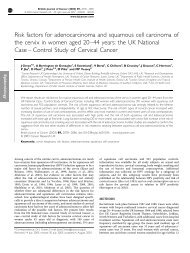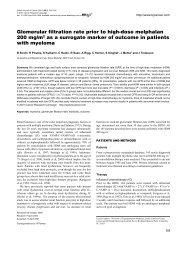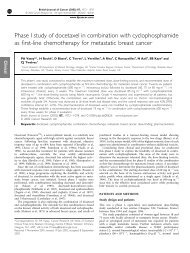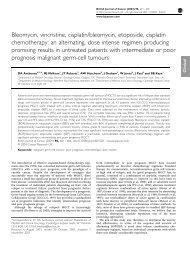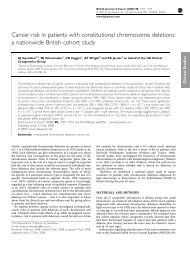Evaluation of the Delta (4) phantom for IMRT and VMAT verification
Evaluation of the Delta (4) phantom for IMRT and VMAT verification
Evaluation of the Delta (4) phantom for IMRT and VMAT verification
You also want an ePaper? Increase the reach of your titles
YUMPU automatically turns print PDFs into web optimized ePapers that Google loves.
This is an author produced version <strong>of</strong> an article that appears in:PHYSICS IN MEDICINE AND BIOLOGYThe internet address <strong>for</strong> this paper is:https://publications.icr.ac.uk/8022/Published text:J L Bed<strong>for</strong>d, Y K Lee, P Wai, C P South, A P Warrington(2009) <strong>Evaluation</strong> <strong>of</strong> <strong>the</strong> <strong>Delta</strong>(4) <strong>phantom</strong> <strong>for</strong> <strong>IMRT</strong> <strong>and</strong> <strong>VMAT</strong><strong>verification</strong>, Physics in Medicine <strong>and</strong> Biology, Vol. 54(9),N167-N176Institute <strong>of</strong> Cancer Research Repositoryhttps://publications.icr.ac.ukPlease direct all emails to:publications@icr.ac.uk
NOTE<strong>Evaluation</strong> <strong>of</strong> <strong>the</strong> <strong>Delta</strong>4 <strong>phantom</strong> <strong>for</strong> <strong>IMRT</strong> <strong>and</strong> <strong>VMAT</strong><strong>verification</strong>.James L Bed<strong>for</strong>d, Young K Lee, Philip Wai, Chnstopher P South, Alan P WarringtonJoint Department <strong>of</strong> PhYSICS, The Institute <strong>of</strong> Cancer Research <strong>and</strong> The Royal Marsden NBS FoundationTrust, Downs Road, Sutton, Suney SM2 5PT.Short title: <strong>Evaluation</strong> <strong>of</strong><strong>Delta</strong>4Classification numbers: 87.55km, 87.55Qr, 87.56FcAbstractThe <strong>Delta</strong>4 diode array <strong>phantom</strong> (Sc<strong>and</strong>idos, Uppsala, Sweden) was evaluated <strong>for</strong> <strong>verification</strong> <strong>of</strong> segmentalintensity-modulated radiation <strong>the</strong>rapy (<strong>IMRT</strong>) <strong>and</strong> volumetric modulated arc <strong>the</strong>rapy (<strong>VMAT</strong>) on an Elektalinear accelerator (Crawley UK). The device was tested <strong>for</strong> angular sensitivity by irradiating it from 36different gantry angles, <strong>and</strong> <strong>the</strong> responses <strong>of</strong> <strong>the</strong> device to various step-<strong>and</strong>-shoot segment doses <strong>and</strong> doserates were evaluated using an ionisation chamber as a comparison. The <strong>phantom</strong> was <strong>the</strong>n compared againstionisation chamber <strong>and</strong> film results <strong>for</strong> two prostate <strong>and</strong> pelvic nodes <strong>IMRT</strong> plans, two head <strong>and</strong> neck <strong>IMRT</strong>plans <strong>and</strong> two lung <strong>VMAT</strong> plans. These plans were calculated using Pinnacle 3 (Philips Radiation OncologySystems, Madison, WI). The unifonnity <strong>of</strong> angular response was better than 0.5% over <strong>the</strong> range <strong>of</strong> gantryangles, with <strong>the</strong> couch having a much larger effect <strong>of</strong> up to 4% depending on <strong>the</strong> obliquity <strong>of</strong> <strong>the</strong> beam inrelation to it. The unifonnity <strong>of</strong> response <strong>of</strong> <strong>the</strong> <strong>Delta</strong>4 to different segment monitor units <strong>and</strong> dose rates wasbetter than 0.5%. The assessment <strong>of</strong> <strong>the</strong> <strong>IMRT</strong> <strong>and</strong> <strong>VMAT</strong> plans showed that <strong>the</strong> <strong>Delta</strong>4 measured a dosewithin 2.5% <strong>of</strong> <strong>the</strong> iomsation chamber <strong>and</strong> compared to film recorded about -2 to +7% more measurementsagreeing with <strong>the</strong> planned dose to wIthm 3% <strong>and</strong> 3 111mThe <strong>Delta</strong>4 IS a complex deVIce <strong>and</strong> requires carefulbenchmarking, but following <strong>the</strong> successful completlon <strong>of</strong> <strong>the</strong>se measurements, <strong>Delta</strong>4 has been introducedmto clmical use.
1. IntroductionComplex radio<strong>the</strong>rapy treatment plans such as those mvolving intensity-modulated radiation <strong>the</strong>rapy (<strong>IMRT</strong>)<strong>and</strong> volumetric modulated arc <strong>the</strong>rapy (<strong>VMAT</strong>) require dosimetric <strong>verification</strong> be<strong>for</strong>e clinical delivery(Ezzell et aI2003). The <strong>Delta</strong>4 <strong>phantom</strong> (Sc<strong>and</strong>idos, Uppsala, Sweden) <strong>of</strong>fers a convenient means <strong>of</strong>achieving this. It consists <strong>of</strong> 1069 p-type Silicon diodes in a crossed alTay inside a cylindricalpolymethylmethacrylate (PMMA) <strong>phantom</strong>, <strong>and</strong> associated computer s<strong>of</strong>tware allows <strong>the</strong> user to compare<strong>the</strong> measured dose distribution <strong>for</strong> a complete treatment plan with <strong>the</strong> dose distribution predicted by <strong>the</strong>treatment planning system. The device records measured dose in relation to <strong>the</strong> individual accelerator pulsesby using a trigger signal from <strong>the</strong> accelerator. Gantry angle is independently sensed by means <strong>of</strong> aninclinometer attached to <strong>the</strong> gantry or accelerator head. As this is a new device with new technology, anevaluation <strong>and</strong> benchmarking process is desirable be<strong>for</strong>e clinical use. Fur<strong>the</strong>rrnore, since <strong>the</strong> device is notstrictly independent <strong>of</strong> <strong>the</strong> accelerator, due to <strong>the</strong> trigger signal obtained from <strong>the</strong> accelerator, it is importantto ensure that <strong>the</strong> device functions correctly <strong>for</strong> <strong>the</strong> accelerator in use. This study <strong>the</strong>re<strong>for</strong>e evaluates <strong>the</strong><strong>phantom</strong> by means <strong>of</strong> basic perf01111ance tests <strong>and</strong> by comparing its results with those produced by <strong>the</strong> moreestablished methods <strong>of</strong> ionisation chamber <strong>and</strong> film (Bed<strong>for</strong>d et a/2008b). Segmental (step <strong>and</strong> shoot) <strong>IMRT</strong><strong>and</strong> <strong>VMAT</strong> are specifically considered, on Elekta linear accelerators.2. Methods2.1. Per<strong>for</strong>mance testsSeveral basic tests were can-ied out to examine specific per<strong>for</strong>mance characteristics <strong>of</strong> <strong>the</strong> <strong>Delta</strong>4 <strong>phantom</strong>.These were not mtended to be an exhaustive characterisation <strong>of</strong> <strong>the</strong> device, but ra <strong>the</strong>r to eva] uate thosefeatures <strong>of</strong> <strong>the</strong> <strong>phantom</strong> in which greater confidence was reqLllred. The <strong>phantom</strong> was calibrated relatively<strong>and</strong> absol~ltelyin <strong>the</strong> 6 MV beam. The November 2008 version <strong>of</strong> <strong>Delta</strong>4 s<strong>of</strong>tware was used <strong>for</strong> all tests, <strong>and</strong><strong>the</strong> work was can-ied out on an Elekta Synergy accelerator with a Beam Modulator head. This acceleratorwas running RTDesktop v7.0 1 <strong>and</strong> was fully commissioned <strong>for</strong> <strong>IMRT</strong> <strong>and</strong> <strong>VMAT</strong> (Hansen et a/1998,Bed<strong>for</strong>d <strong>and</strong> Warrington 2009). The couch top was a carbon-fibre iBeam EVa type (Elekta/MedicalIntelligence) <strong>and</strong> <strong>the</strong> measurements were carried out approximately 0.5m from <strong>the</strong> end <strong>of</strong> <strong>the</strong> full widthsection.
2.1.1. Angular sensitivityThe diodes in <strong>the</strong> <strong>phantom</strong> have an inherent angular sensitivity to radJation. This is corrected <strong>for</strong> by <strong>the</strong><strong>Delta</strong>4 s<strong>of</strong>tware, which compensates according to <strong>the</strong> known gantry angle <strong>of</strong> <strong>the</strong> beam being delivered. Inorder to check <strong>the</strong> accuracy <strong>of</strong> this cOlTection, 36 ] 0.4 x 9.6 cm beams with 200 MU were delivered at 10°intervals around <strong>the</strong> <strong>phantom</strong>. (10.4 x 9.6 cm on a Beam Modulator head is <strong>the</strong> equivalent <strong>of</strong> a lOx 10 cmfield on a normal head.) The response <strong>of</strong> <strong>the</strong> <strong>phantom</strong> was measured using <strong>the</strong> daily output cOlTectionfacility <strong>of</strong> <strong>the</strong> <strong>Delta</strong>4. (The daily output correction measures <strong>the</strong> overall response <strong>of</strong> <strong>the</strong> <strong>Delta</strong>4 in relation toan arbitrary treatment plan, <strong>and</strong> <strong>of</strong>fers <strong>the</strong> correction factor needed <strong>for</strong> agreement with that treatment plan;<strong>the</strong> reCIprocal <strong>of</strong> this factor <strong>the</strong>re<strong>for</strong>e gives <strong>the</strong> <strong>Delta</strong>4 response.)2.1.2 Linearity <strong>of</strong>segment doseAn earlier version <strong>of</strong> <strong>Delta</strong>4 s<strong>of</strong>tware was found to be inaccurate <strong>for</strong> multiple low-MU lMRT segments. Thelinearity <strong>of</strong> <strong>the</strong> <strong>Delta</strong>4 <strong>for</strong> delivery <strong>of</strong> segmental beams was <strong>the</strong>re<strong>for</strong>e checked. A series <strong>of</strong> 10.4 x 9.6 cmbeams were delivered at gantry angle 0°. The beams were <strong>for</strong> one segment with 80 MU, two segments with40 MU each, four segments with 20 MU each, <strong>and</strong> eight segments with 10 MU each. The response <strong>of</strong> <strong>the</strong><strong>phantom</strong> was measured using <strong>the</strong> daily output correction factor. A 0.6 cm 3 Farmer ionisation chamber (SaintGobain Crystals <strong>and</strong> Detectors, Reading, UK) was positioned under 3 cm <strong>of</strong> Solid Water (RadiationMeasurements, Inc., Middleton, WI) centrally beneath <strong>the</strong> <strong>Delta</strong>4 <strong>phantom</strong> so as to correct <strong>for</strong> any truevariation in accelerator output.,,/2.1.3 Dose rate dependenceThe output <strong>of</strong> <strong>the</strong> <strong>Delta</strong>4 was examined as a function <strong>of</strong> dose rate. A series <strong>of</strong> 10.4 x 9.6 cm beams weredel ivered at gantry angle 0°. The dose rate <strong>of</strong> <strong>the</strong> beam was set to 600 MU/min, 300 MU/min, 150 MU/min,75 MU/min <strong>and</strong> 37 MU/min. The output <strong>of</strong> <strong>the</strong> <strong>Delta</strong>4 was measured using <strong>the</strong> daily output cOlTectionfactor. A Farmer chamber \vas also used to sll11Ultaneously correct <strong>for</strong> <strong>the</strong> accelerator output as in 2.1.2above. Ion recombmation wIthin <strong>the</strong> ionisation chamber was measured at 600 MU/mm <strong>and</strong> 37 MU/min <strong>and</strong>fOlmd to be around 0.5% in both cases, which was expected, as <strong>the</strong> dose per pulse <strong>of</strong> <strong>the</strong> Elekta accelerator ISconstant at all dose rates. As ion recombinatlOn \VdS clearly a constant factor 111 <strong>the</strong> measurements <strong>of</strong> doserate dependence, it was subsequently neglected
2.2. Comparison studiesHavmg established that <strong>the</strong> basic per<strong>for</strong>mance <strong>of</strong> <strong>the</strong> <strong>Delta</strong>4 was satisfactory, <strong>the</strong> device was compared with<strong>the</strong> more traditional <strong>IMRT</strong> plan <strong>verification</strong> methods usmg ionisation chamber <strong>and</strong> film in a water-equivalent<strong>phantom</strong>. Six treatment plans \vere considered: two prostate <strong>and</strong> pelvic nodes <strong>IMRT</strong> plans, two head <strong>and</strong>neck <strong>IMRT</strong> plans <strong>and</strong> two lung <strong>VMAT</strong> plans. The prostate <strong>and</strong> pelvic nodes plans consisted <strong>of</strong> fivesegmental (step <strong>and</strong> shoot) beams, with approximately 10 segments per beam (Adams et al2004), while <strong>the</strong>head <strong>and</strong> neck plans consisted <strong>of</strong> seven beams with approximately 10 segments per beam. The <strong>VMAT</strong> planseach consisted <strong>of</strong> a smgle gantry arc (Bed<strong>for</strong>d et al2008a). The <strong>IMRT</strong> plans were computed on <strong>the</strong>Pinnacle 3 treatment planning system (Philips Radiation Oncology Systems, Madison, WI), <strong>and</strong> <strong>the</strong> <strong>VMAT</strong>plans were generated usmg an in-house program AutoBeam <strong>and</strong> a final dose calculation was made withinPinnacle 3 . The Pinnacle 3 treatment planning system had previously been fully commissioned <strong>for</strong> <strong>IMRT</strong>(Bed<strong>for</strong>d et al2003, 2004). As <strong>the</strong> use <strong>of</strong> <strong>the</strong> planning system with <strong>the</strong> <strong>Delta</strong>4 involved calculating dose inPMMA, some additional measurements were made to ensure that Pinnacle 3 was perfonning this correctly.The six treatment plans were verified using an ionisation chamber <strong>and</strong> film, prior to patienttreatment. The plans were delivered using an Elekta Synergy accelerator with st<strong>and</strong>ard multileafcollimatorhead <strong>and</strong> RTDesktop v7.01, <strong>and</strong> daily output <strong>of</strong> <strong>the</strong> accelerator was corrected <strong>for</strong> in all cases. The ionisationchamber measurements were made with a 0.6 cm 3 Fanner chamber 111 a rectangular stack <strong>of</strong> Solid Water in aregion <strong>of</strong> homogeneous dose. The film measurements were made using EDR2 (Eastman Kodak, Rochester,NY) <strong>and</strong> Gafchromic EBT (Intemational Specialty Products, NJ) film. The film was located coronally in <strong>the</strong>same Solid Water stack as <strong>the</strong> ionisation chamber. The films were analysed using OmniPro I'mRT(Wellhbfer-Sc<strong>and</strong>itronix, Schwarzenbruck, Gennany) <strong>and</strong> nonnalised to a region <strong>of</strong> homogeneous dose.Ionisation chamber readings were required to be within 3% <strong>of</strong>TPS dose, <strong>and</strong> 90% <strong>of</strong> each film was requiredto satisfy a gamma criterion <strong>of</strong> 3% <strong>and</strong> 3 mm (Low et al 1998). For <strong>the</strong> <strong>Delta</strong>4 evaluation, <strong>the</strong> plans weredelivered to <strong>the</strong> <strong>Delta</strong>4 <strong>phantom</strong> <strong>and</strong> <strong>the</strong> response compared with <strong>the</strong> lOnisatiol1 chamber <strong>and</strong> filmmeasurements. The absolute dose was assessed USlllg <strong>the</strong> daily output correction factor, <strong>and</strong> <strong>the</strong> overa]]response was measured by recording <strong>the</strong> percentage <strong>of</strong> <strong>the</strong> measurements agreeing with <strong>the</strong> plan to within3% <strong>and</strong> 3 mm.
3. Results3.1. Per<strong>for</strong>mance tests3.1.1. Angular responseThe angular response <strong>of</strong> <strong>the</strong> <strong>Delta</strong>4 at a range <strong>of</strong> gantry angles IS shown in Figure I. The variation <strong>of</strong> <strong>the</strong>response from 270° through 0° to 90° shows that <strong>the</strong> variation 1n response is less than 0.5%. The effect <strong>of</strong>couch attenuation is included m <strong>the</strong> plot to show that this is much larger than <strong>the</strong> inherent <strong>Delta</strong>4 sensitivityto gantry angle.3.1.2. Linearity <strong>of</strong>segment doseThe response <strong>of</strong> <strong>the</strong> ionisation chamber <strong>and</strong> <strong>Delta</strong>4 as a function <strong>of</strong><strong>IMRT</strong> segment dose <strong>and</strong> number isshown in Figure 2. The response <strong>of</strong> <strong>the</strong> ionisation chamber is taken to represent <strong>the</strong> output <strong>of</strong> <strong>the</strong> accelerator.Compared to <strong>the</strong> ionisation chamber, it is clear that <strong>the</strong> <strong>Delta</strong>4 responds linearly to within 0.5% to <strong>the</strong>different <strong>IMRT</strong> segmentations.3.1.3. Dose rate dependenceThe response <strong>of</strong> <strong>the</strong> ionisation chamber <strong>and</strong> <strong>Delta</strong>4 as a function <strong>of</strong> accelerator dose rate is shown in Figure3. Again; <strong>the</strong> ionisation chamber is taken to represent <strong>the</strong> accelerator output. The <strong>Delta</strong>4 responds to alldose rates similarly, to within 0.5% <strong>of</strong> <strong>the</strong> ionisation chamber.3.2. Comparison studiesAn example <strong>of</strong> <strong>the</strong> <strong>Delta</strong>4 output <strong>for</strong> one <strong>of</strong> <strong>the</strong> head <strong>and</strong> neck cases is shown in Figure 4, <strong>and</strong> <strong>the</strong>comparison <strong>of</strong> <strong>Delta</strong>4 with iomsation chamber <strong>and</strong> film <strong>for</strong> all <strong>of</strong> <strong>the</strong> chmcal cases is shown in Table I.There is no particular trend in <strong>the</strong> differences between doses recorded by ionisation chamber <strong>and</strong> <strong>Delta</strong>4, but<strong>the</strong> agreement is to within ±2.5%. On average, <strong>the</strong> <strong>Delta</strong>4 records a higher percentage <strong>of</strong> points agreeingwith <strong>the</strong> planned dose to within 3% <strong>and</strong> 3 mm than film, with <strong>the</strong> range, relative to fJlm, bemg from -2°;() to+7%.
4. DiscussionThe <strong>Delta</strong>4 at first appears to be a straIght<strong>for</strong>ward device <strong>for</strong> measuring dose. However, because <strong>of</strong> <strong>the</strong>connection to <strong>the</strong> accelerator trigger output, which means that it is not necessarily completely independent <strong>of</strong><strong>the</strong> accelerator, <strong>and</strong> because <strong>of</strong> <strong>the</strong> various s<strong>of</strong>tware conections made to <strong>the</strong> basic diode response aftermeasurement, <strong>the</strong> device is complex <strong>and</strong> careful quality assurance <strong>and</strong> benchmarking be<strong>for</strong>e use is <strong>the</strong>re<strong>for</strong>erecommended. In particular, <strong>the</strong> treatment plan to be verified must be recalculated on an artificial CT scan<strong>of</strong> <strong>the</strong> <strong>Delta</strong>4 <strong>phantom</strong>, which has a higher density than water. This density is less than optimal <strong>for</strong> mosttreatment planning systems. In <strong>the</strong> case <strong>of</strong> Pinnacle 3 used in this study, it is known that <strong>the</strong> dose is subJ ect tosome uncertainty at high tissue density (Bed<strong>for</strong>d et aI2003). Fur<strong>the</strong>r measurements canied out specificalJyin PMMA (results not shown) have shown that <strong>the</strong> dose calculated by Pinnacle 3 <strong>for</strong> simple fields on PMMAis accurate to around ±2%.The perfonnance tests can-ied out in this study show that <strong>the</strong> basic DeJta4 behaviour is accurate. Theangular response is unifonn over <strong>the</strong> complete range <strong>of</strong> gantry angles, with <strong>the</strong> couch attenuation being amuch larger factor. For a <strong>VMAT</strong> plan, where roughly one third <strong>of</strong> <strong>the</strong> arc is through <strong>the</strong> couch, <strong>the</strong> iBeamEVa couch attenuation causes a drop in overalJ central dose <strong>of</strong> around 1%. The response <strong>of</strong> <strong>the</strong> <strong>Delta</strong>4 <strong>for</strong>segmental <strong>IMRT</strong> beams is accurate to within 0.5%, <strong>and</strong> <strong>the</strong> device h<strong>and</strong>les <strong>the</strong> variable dose rate required <strong>for</strong><strong>VMAT</strong> properly.For <strong>the</strong> plan comparisons, <strong>the</strong> <strong>Delta</strong>4 absolute response is within about 2.5% <strong>of</strong> <strong>the</strong> ionisationchamber measurements. However, as <strong>the</strong> ionisation chamber measurement is over a much smaller volumethan <strong>the</strong> <strong>Delta</strong>4 measurement, perfect agreement is not expected. Couch attenuation is present on both <strong>the</strong>ionisation chamber <strong>and</strong> <strong>Delta</strong>4 measurements. The gamma measurements are in reasonable con-elation, with<strong>the</strong> cylindrical <strong>Delta</strong>4 showmg slightly better agreement between measured <strong>and</strong> calculated dose than <strong>the</strong> filmm <strong>the</strong> cuboid <strong>phantom</strong>.Several general features cause that <strong>the</strong> results <strong>of</strong> <strong>the</strong> <strong>Delta</strong>4 should not necessanly be tested against<strong>the</strong> same criteria as <strong>the</strong> results <strong>of</strong> film <strong>and</strong> ionisatlOn chamber. In particular, <strong>Delta</strong>4 uses a three-dimensIonalgamma calculatlOn, \-vh]ch IS more challengIng than tIle two-dimenslOnal one used <strong>for</strong> film. Moreover, <strong>Delta</strong>4measurements are absolute, as opposed to measurements wlth film, which are relative. Consequently, anabsolute dose dIfference manifests Itself in <strong>the</strong> <strong>Delta</strong>4 gamma, whereas such a dJfference ]S tYPIcallyremoved in <strong>the</strong> film gamma by normahsation. ~~n <strong>the</strong> o<strong>the</strong>r h<strong>and</strong>, <strong>the</strong> <strong>Delta</strong>4 is not susceptIble to errors 111
calibration <strong>and</strong> processmg like film. Based on <strong>the</strong> results <strong>of</strong> <strong>the</strong>se tests, it seems reasonable to maintain atolerance <strong>of</strong>90% <strong>of</strong> <strong>the</strong> gamma map achieving 3% <strong>and</strong> 3mm agreement, or perhaps tighten <strong>the</strong> toleranceslightly to 95% <strong>of</strong> <strong>the</strong> gamma map achieving 3% <strong>and</strong> 3mm.Following <strong>the</strong>se successful comparative measurements, <strong>the</strong> <strong>Delta</strong>4 has been introduced into clinicaluse <strong>for</strong> <strong>IMRT</strong> <strong>and</strong> <strong>VMAT</strong> <strong>verification</strong>.AcknowledgmentsWe would like to thank Elekta Ltd <strong>for</strong> <strong>the</strong>ir collaboration. We would also like to thank <strong>the</strong> team at<strong>the</strong> Royal Marsden NHS Foundation Trust <strong>for</strong> <strong>the</strong>ir support <strong>of</strong> this project. We are grateful to Mr GorgenNilsson <strong>of</strong> Sc<strong>and</strong>idos <strong>for</strong> his assistance during <strong>the</strong> commissioning <strong>of</strong> <strong>the</strong> <strong>Delta</strong>4. We acknowledge .l\THSfunding to <strong>the</strong> NIHR Biomedical Research Centre.ReferencesAdams E J, Convery D J, Cosgrove Y P, McNair H A, Staffurth J N, Yaarkamp J, Nutting C M, WarringtonA P, Webb S, Balyckyi J <strong>and</strong> Deamaley D P 2004 Climcal implementation <strong>of</strong>dynamic <strong>and</strong> step-<strong>and</strong>shoot<strong>IMRT</strong> to treat prostate cancer with high risk <strong>of</strong> pelVIC lymph node involvement Radio<strong>the</strong>r.Oneol. 70 1-10Bed<strong>for</strong>d J L, Childs P J, Nordmark Hansen V, Mosleh-Shirazl M A, Verhaegen F <strong>and</strong> Warrmgton AP 2003Commissioning <strong>and</strong> quality assurance <strong>of</strong> <strong>the</strong> Pinnacle 3 radio<strong>the</strong>rapy treatment planning system <strong>for</strong>external beam photons Br. J Radiol. 76 163-76Bed<strong>for</strong>d J L, Childs P J <strong>and</strong> Warrington A P 2004 Venflcation <strong>of</strong> inverse planning <strong>and</strong> treatment dehvery <strong>for</strong>segmentallJ\!IRT J Appl. Clill. Med. Phys. 5 1-17Bed<strong>for</strong>d J L, Hansen V N, McNair H A, Aitken A H, Brock J E C, Warrington A P <strong>and</strong> Brada M 2008Treatnient <strong>of</strong>lung cancerusing volumetric modulated arc <strong>the</strong>rapy <strong>and</strong> image guidance: A case studyActa Oncol. 47 1438-43Bed<strong>for</strong>d J, Wai P, Lee Y, South C <strong>and</strong> Wanmgton A 2008 <strong>Evaluation</strong> <strong>of</strong> <strong>the</strong> <strong>Delta</strong>4 diode array <strong>phantom</strong> <strong>for</strong><strong>IMRT</strong> <strong>and</strong> YMAT venfication Proc. IPEMBiennial Radio<strong>the</strong>rapy Meeting (Bath, UK, 2-4September 2008) ed T nett (York: lPEM) p 122
Bed<strong>for</strong>d.T L<strong>and</strong> WalTington A P 2009 Commissioning <strong>of</strong> volumetric modulated arc <strong>the</strong>rapy (<strong>VMAT</strong>) Inl. 1.Radial. Oneal. BioI. Phys. in pressEzzell G A, Galvin J M, Lo'vv D, Palta J R, Rosen I, Sharpe M B, Xla P, Xiao Y, Xing L<strong>and</strong> Yu C X 2003Guidance document on delivery, treatment planning, <strong>and</strong> clinical Implementation <strong>of</strong><strong>IMRT</strong>: Report<strong>of</strong> <strong>the</strong> <strong>IMRT</strong> subcommittee <strong>of</strong> <strong>the</strong> AAPM radiation <strong>the</strong>rapy committee Med. Phys. 302089-115Hansen V N, Evans PM, Budgell G J, Mott J H L, Williams P C, Brugmans M J P, Wittkamper F W,Mijnheer B J <strong>and</strong> Brown K 1998 Quality assurance <strong>of</strong> <strong>the</strong> dose delivered by small radiationsegments Phys. Med. BioI. 43 2665-75Low D A, Harms W B, Mutic S <strong>and</strong> Purdy J A 1998 A tec1mique <strong>for</strong> <strong>the</strong> quantitative evaluation <strong>of</strong> dosedistributions Med. Phys. 2S 656-61
FiguresANGULAR RESPONSE on iBeam EVOo~,020OO\~ I k! ~o " 4050280 70270 80260 90250 100240 110230 120220 130210 140200197016015018060Figure 1100.4100.2LINEARITY100.0 - -..;,,;-- ~ 99.8 I ----..- --------------~"-'- ........""-Q)rF1-.o 99.6 .....~--99.4 I99.299.01x80 2x40 4x20 8x10Segment number & size (MU)Figur'e 2
101.0100.5DOSE RATE-.100.0c ~'--"a.l 99.5rh0Q99.098.5-.--.....".- ... 98.0600 300 150 75 37Dose rate (MU/min)Figure 3~ .. ·~::::.Fbl..'.... rt ~?iJ.;.::_"'l.1.-1..,.~).'(r,' -"1$,.-: .~~~.!~c.·." ..,~ i'W~~.':';~'~~I'~~Jn . , ... (~f~.. :::::.. -~;.1 (je ~~ ~.J ..; .d ,,j~:~>1:UI~ 1~{M!2!)OCI)J)J~ltd> U!!tI1;).I.'1.' "::) ..·~~,.".,..,t"'J@:!JJI~:.....," ··O·8;;:·:::~J)·;t.:;T;~;~·;r~;~;~r--··- .~- Ph,lll$)'~"' .• _>'1;' .>,1••-!-_....1::'1, ~lfiL I "i'I I;: ] ~I__ .._ t. \~"-. r.,.... .:., dflI!!J1~N:;ur~~~·j(n,OO~;i....fi:-i,r.edt.«.,$ItUC!lt~(:Ol.
Figure captionsFigure 1. <strong>Delta</strong>4 response as a function <strong>of</strong> gantry angle. The circumferential axis shows gantry angle indegrees, <strong>and</strong> <strong>the</strong> radial aXIs shows <strong>the</strong> percentage <strong>Delta</strong>4 response, nonnahsed to <strong>the</strong> response at gantry angle0°. The attenuation due to <strong>the</strong> couch is included in <strong>the</strong> response.Figure 2. Variation <strong>of</strong> <strong>Delta</strong>4 response, as a function <strong>of</strong>number <strong>of</strong> segments <strong>and</strong> segment monitor units.Solid line: <strong>Delta</strong>4 response; dashed line: iomsation chamber response, representing accelerator output.Normalised to 1 X 80 MU response.Figure 3. Variation <strong>of</strong> <strong>Delta</strong>4 response as a function <strong>of</strong> accelerator dose rate. Solid line: <strong>Delta</strong>4 dose; dashedlme: ionisation chamber dose, representing accelerator output. Normalised to 600 MU/mm.Figure 4. <strong>Delta</strong>4 output <strong>for</strong> one <strong>of</strong> <strong>the</strong> head <strong>and</strong> neck cases. The two main panels show <strong>the</strong> planned dosedistribution in greyscale <strong>and</strong> <strong>the</strong> measured dose in colour over <strong>the</strong> two detector planes. The histograms show(from left to right) dose deviation, distance to agreement <strong>and</strong> gamma (3% <strong>and</strong> 3 mm) <strong>of</strong> <strong>the</strong> measurements inrelation to <strong>the</strong> treatment planning system.
TablesTable 1. Comparison <strong>of</strong> ionisation chamber, film <strong>and</strong> DeJta4. The IOnisation chamber difference is <strong>the</strong>percentage difference <strong>of</strong> <strong>the</strong> measured dose in relation to <strong>the</strong> dose ca lculated by <strong>the</strong> treatment planningsystem. <strong>Delta</strong>4 difference is <strong>the</strong> response indicated by <strong>the</strong> daily conection factor. Gamma results are <strong>the</strong>percentage <strong>of</strong> points passing <strong>the</strong> gamma criterion <strong>of</strong> 3%/3mm.Case Ion chamber diff (%) Film r (%) <strong>Delta</strong>4 diff (%) <strong>Delta</strong>4 r (%)<strong>IMRT</strong> prostate/pelvic nodes -0.4 89.2 -2.3 96.1<strong>IMRT</strong> prostate/pelvic nodes -1.0 98.2 -1.6 98.7<strong>IMRT</strong> head/neck -1.0 91.5 1.2 97.7<strong>IMRT</strong> head/neck -0.6 93.2 0.2 96.5<strong>VMAT</strong> lung -1.1 97.6 -2.2 95.7<strong>VMAT</strong> lung 2.3 91.5 0.1 98.8




